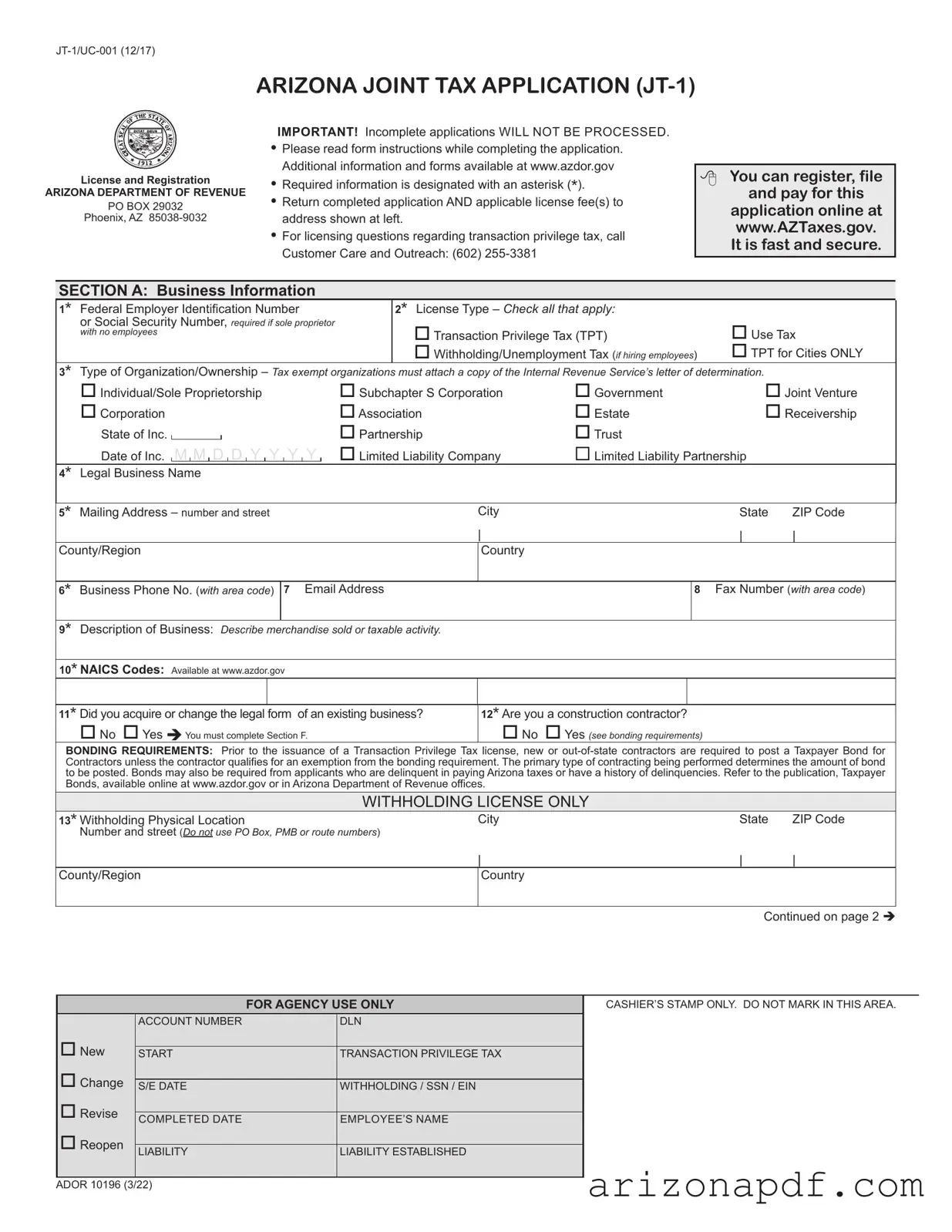What is the JT-1 Arizona Tax Form used for?
The JT-1 Arizona Tax Form, officially known as the Arizona Joint Tax Application, serves multiple purposes. It's primarily used to apply for different tax-related requirements for businesses operating within the state, including the Transaction Privilege Tax (TPT), Use Tax, and Employer Withholding and Unemployment Insurance. Additionally, this form facilitates changes in business ownership or the legal structure of the business.
Can I submit the JT-1 Form online?
Yes, the JT-1 Form can be submitted online, which is the recommended approach for faster processing. The Arizona Department of Revenue’s website, www.AZTaxes.gov, provides an online application process. However, it's worth noting that construction contractors, due to bonding requirements, cannot apply for the TPT license online. For such cases or further information, contacting the department directly is advised.
Is there a fee associated with the JT-1 form?
Yes, there are various fees associated with the JT-1 form, including state, county, and possibly city license fees, which are dependent on the number of business locations and the specific tax licenses required. A breakdown of fees, including city-specific fees and exemptions, is detailed in the State/County & City License Fee Worksheet section of the JT-1 form documentation. It's important to calculate the total amount due accurately and include payment with the submission of your application.
What information is required on the JT-1 Form?
The JT-1 Form requires detailed business information including: Federal Employer Identification Number (FEIN) or Social Security Number (SSN) if a sole proprietor, license types needed, type of organization/ownership, business name and contact details, business description, NAICS codes, and information about bonding requirements for contractors. Also, for those hiring employees, details regarding withholding and unemployment tax must be provided. Mark sections requiring your attention with an asterisk (*).
What is the Transaction Privilege Tax (TPT)?
The Transaction Privilege Tax (TPT) is a tax on the privilege of conducting business in the state of Arizona. It is a tax that the business owner is responsible for paying, but it is common for the business to pass the tax on to the customer. Various business activities require a TPT license, such as retail sales, leasing, and renting tangible personal property.
How do I determine the filing frequency for my taxes?
When completing the JT-1 form, you'll decide on your tax filing frequency—monthly, quarterly, seasonally, or annually—based on your estimated tax liability and business operations. Your choice affects when you are required to submit your tax returns and payments to the state.
Does my business need to pay for licenses for each city it operates in?
Yes, if your business operates in multiple cities, you may need to pay additional license fees specific to each city in addition to the state license fee. The exact fees and any associated requirements vary by city. The JT-1 form’s State/County & City License Fee Worksheet helps in calculating these fees.
What are the bonding requirements mentioned in the JT-1 form?
Bonding requirements apply primarily to construction contractors. Before the issuance of a Transaction Privilege Tax license, new or out-of-state contractors must post a Taxpayer Bond unless they qualify for an exemption. The bond amount varies depending on the primary type of contracting performed. Further details and exemption criteria can be found in the Taxpayer Bonds publication on the Arizona Department of Revenue website.
Can I use the JT-1 form if I'm changing the ownership or legal form of my existing business?
Yes, if you're acquiring, succeeding to a portion of, or entirely changing the ownership or legal form of an existing business, you can use the JT-1 form to notify the state of these changes. It's crucial to complete this process to ensure your business remains in compliance with state tax laws.
Who needs to sign the JT-1 form?
The JT-1 form must be signed by an individual authorized to act on behalf of the business. This includes a sole owner, at least two partners in the case of a partnership, a managing member, a corporate officer, a trustee, a receiver, or a representative of an estate. This ensures that the form has been reviewed and approved by someone with legal responsibility for the business.









